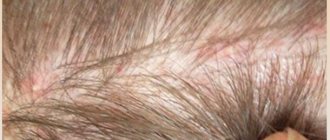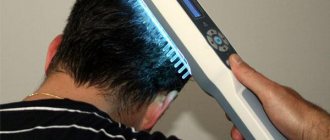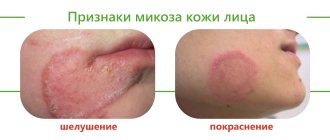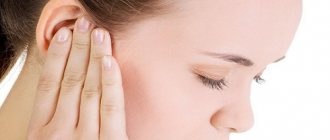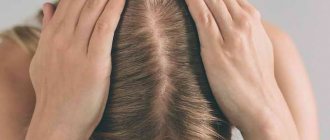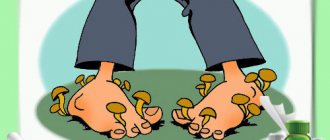Scalp diseases: names and causes
Common skin diseases are considered to be:
- diseases of a dermatological nature (including seborrhea, eczema and hyperkeratosis);
- autoimmune diseases of the scalp (including psoriasis and scleroderma);
- infectious (formation of pustules, appearance of lice, etc.);
- fungal rashes.
Whatever the cause of the disease, it must be eliminated in time. It is important to start treatment as early as possible, because wasted time can have serious consequences.
Classic alopecia. Androgenetic (male) and diffuse (female) alopecia
These are the two most common situations in medical practice. The cause of androgenetic alopecia (AGA) is most often genetics, followed by provoking factors: stress, lack of microelements, vitamins, trichotoxic drugs, etc. Therefore, more often we call AGA not a disease, but a pathological condition.
What is characteristic of the female type of hair loss is that, in addition to genetics, hormonal problems (usually sex hormones) are in second place, and in this case, alopecia can often occur after various diseases.
Now let's look at the effect of provoking factors in more detail.
Causes and signs of dermatological diseases
The appearance of dermatological diseases of the scalp in a patient occurs when the sebaceous glands work abnormally. For example, the well-known disease seborrhea occurs in people who constantly live in a stressful state, which leads to a malfunction of the gastrointestinal tract, and constant snacking on fast food and sweets only worsens the clinical picture.
Seborrhea can occur as a result of hormonal imbalance. Moreover, it is observed equally in both the male and female populations in equal numbers. Rare causes of the disease include hereditary predisposition. It's rare, but it happens. At the moment, doctors cannot answer with certainty which link in the genetic code is responsible for the transmission of seborrhea in the family.
Self-medication is not recommended - it can only cause harm. To establish an accurate diagnosis, you need to contact a specialist in skin diseases, who will refer you to an andrologist/gynecologist to identify pathological processes in the reproductive system. Based on the results obtained, adjustments are made to the diet, physiotherapy is prescribed, and, if necessary, a diet and a course of medications.
Damage to the hair shaft
Damage to the hair shaft can be mechanical, thermal, or chemical. It is very easy to damage the hair shaft as a result of inept hairdressing manipulations - curling, hair dyeing, etc. Typically, damage to the hair shaft does not lead to hair loss, but is almost always accompanied by splitting of the ends, increased fragility, and loss of elasticity inherent in healthy hair. Similar phenomena can also be caused by nervous stress, unfavorable living conditions, and poor nutrition. It’s not for nothing that hair is sometimes called a barometer of health: any deterioration in the body’s condition inevitably affects the structure of the hair, i.e. on the appearance of our hairstyle.
Fungal diseases: causes and symptomatic picture
Fungal diseases of the scalp partially or completely affect the scalp. They are transmitted through tactile contact and the use of shared personal hygiene products (towel, comb), clothing and hats.
A common fungal disease is ringworm. The superficial form most often affects children of preschool and school age due to curiosity and frequent contacts with animals - cattle and rodents. According to statistics, lichen more often affects residents of villages and villages.
In most cases, it is characterized by the appearance of small spots, pinkish with a pale edge. Despite its frequent distribution among children, trichophytosis can appear in men and women of different age categories.
Treatment of fungal diseases of the scalp can take an indefinite period of time. If the disease is chronic, treatment of the scalp disease in this case does not guarantee complete relief.
Infectious diseases
The most common infectious diseases of the hair and scalp are pediculosis, microsporia and trichophytosis. Pediculosis develops as a result of parasitism on the scalp by blood-sucking insects ─ head lice. Their bites are accompanied by severe itching, which leads to multiple scratches on the skin. In places of scratching, ulcers or scars often form. Hair loss due to pediculosis is minimal, but the structure of the hair itself is disrupted as parasites attach eggs (nits) to the hair shafts. To treat head lice, drugs based on benzyl benzoate are used. A prerequisite is the mechanical destruction of nits and adult lice.
Fungal infections of the hair and scalp include microsporia and trichophytosis (ringworm). On smooth skin, the lesions have rounded outlines; their shape is more clearly expressed in microsporia. The skin on the affected areas is hyperemic and covered with scales. Most patients experience extensive hair loss due to hair breaking off at a level of 2-6 mm from the surface of the skin. In places of hair loss, stumps (short fragments of hair) remain; with ringworm, their color is usually black, and with microsporia, it is whitish, resembling a mold coating. To treat these diseases, antifungal drugs are used in the form of local applications, injections or tablets for oral administration.
Autoimmune diseases: causes and methods of treatment
For healthy people, patients with psoriasis or scleroderma do not pose any threat; these diseases are associated with a deficiency of essential vitamins and minerals in the body. The patient must be protected from situations that cause depression, anxiety and stress, after which the doctor prescribes oral drug treatment, namely:
- take a course of medications with a high content of vitamins, amino acids and minerals necessary for the recovery of the body;
- sedatives (if the patient is unable to get rid of stress on his own).
Alopecia areata
Alopecia areata is an autoimmune disease in which T lymphocytes and other immune cells reversibly “paralyze” hair follicles.
Alopecia areata has a very variable course, manifesting clinically as any of the following:
A single small lesion that resolves spontaneously Multiple, concurrently presenting lesions of alopecia, including some with hair regrowth and others of recent occurrence Several large lesions, often confluent, that may persist for years Complete hair loss that persists for decades
One third of patients experience spontaneous remission within six months of initial presentation; 50–80% are asymptomatic after one year (23).
Treatment for alopecia areata depends on the severity of the lesion (23). If the disorder is mild and does not cause much concern to the patient, waiting for spontaneous remission is a reasonable choice. Treatment with zinc, as a possible immunomodulator, usually has no side effects and is therefore suitable for use in children (e10). Topical corticosteroids can be used for several weeks without risk, but their effectiveness in alopecia areata has not been established (20). A clear benefit was noted in a double-blind study of high-dose steroid foam with control in the same patient (right versus left side of the head) (24).
Alternatively, alopecia areata can be treated with triamcinolone injections given into the affected tissue. This method of treatment can be tried if the patient has only a few stable foci of alopecia. In rare cases, systemic corticosteroids are useful (25).
Spontaneous remission of alopecia areata
If the disorder is mild and does not bother the patient much, waiting for spontaneous remission is a reasonable choice.
The most effective treatment (level of evidence: 2) is topical immune therapy with diphenylcyclopropenone or dibutyl squaric acid (23). The mechanism of action is competitive inhibition of responsible T-lymphocytes due to the induction of type IV allergic reaction to one of the two substances used; each of them is an obligate chemical allergen not normally present in the environment. After allergic dermatitis caused in this way, hair can grow back after 3–6 months. The proportion of responders varies from 30 to 80% depending on the initial level, i.e., on the area of the lesion and the duration of the disease (20).
Various other therapeutic approaches will not be discussed here due to lack of space and scientific evidence, for example: dithranol stimulation, PUVA turban therapy, 308 nm excimer laser, methotrexate/prednisolone and sulfasalazine (20, 23, 25).
Current biological agents, such as TNF-α antagonists, are surprisingly ineffective and may even cause alopecia areata; thus they are not recommended (22, 23). It is hoped that JANUS kinase inhibitors (mainly for topical use) will have beneficial effects (e11).
Effective treatment for alopecia areata
The most effective treatment (level of evidence: 2) is topical immune therapy with diphenylcyclopropenone or dibutyl squaric acid.
Atypical types of hair loss
The so-called idiopathic alopecia (that is, with an unknown cause) includes focal forms. They are characterized by the formation of areas devoid of hair. There are single, multiple, subtotal, total and universal forms of alopecia. In a one-time, first case, the hairline often recovers on its own without treatment within a year (with the exception of the universal form).
The cicatricial form (Broca's pseudopelade) is also known. In this case, a transplant is indicated; the treatment is ineffective, since the root is replaced by connective tissue, that is, in fact, there is nothing to treat.
In what cases should you contact a trichologist?
- Increased hair loss began
- Hair began to thin
- Areas of baldness have appeared on any part of the skin
- Crusts, ulcers, and pustules appeared on the scalp
- There is an itch
- Dandruff appears
- Early gray hair appeared
- Hair has lost elasticity, shine, strength
- The structure of the hair shaft has changed (it has become thinner, more brittle...)
- Desire to strengthen and prevent hair loss/thinning
Post-COVID hair loss
Recently, the number of patients complaining of very severe hair loss has increased. Very characteristic signs are a flurry of sudden hair loss, which occurs all at once, in one day, and rapid (2-4 weeks) loss of volume 2-3 months after suffering from COVID. Initially, doctors believed that this was a reaction to aggressive therapy, but then patients began to come in who suffered from the disease in a mild form or were completely on their feet. Conclusion: the virus itself has a trichotoxic effect. Treatment with a trichologist is required if hair loss lasts more than 1–2 weeks. The prognosis is usually positive.
